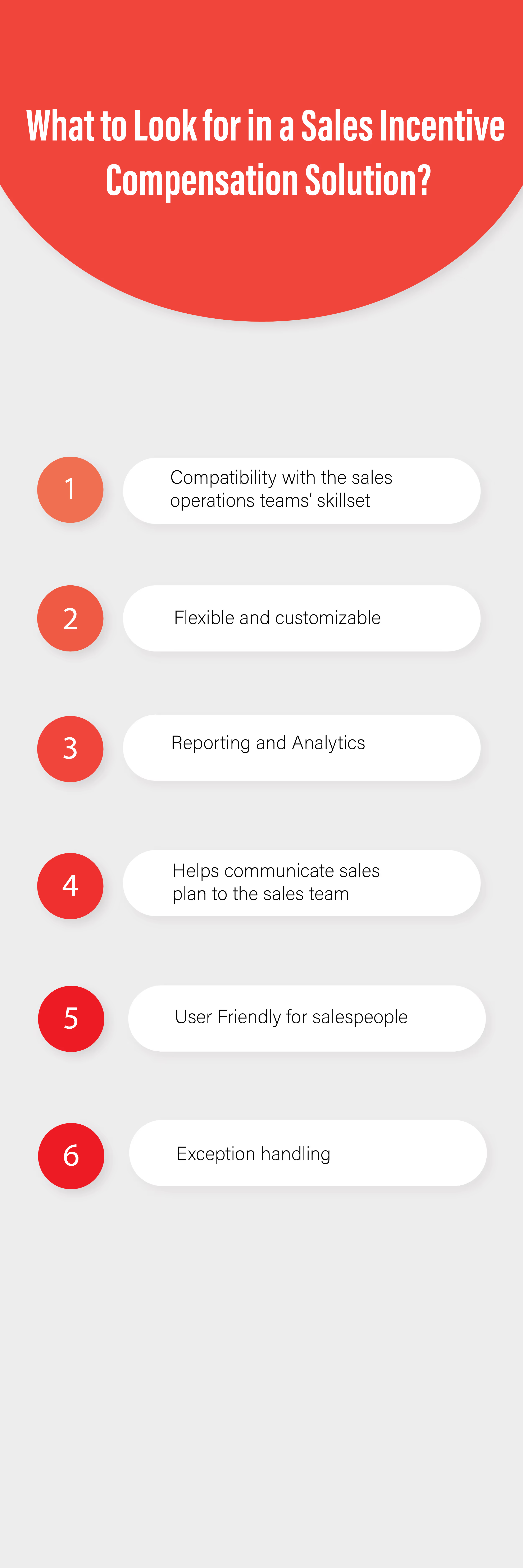
Blog
What to Look for in a Sales Incentive Compensation Solution?
July 25, 2022


Key Insights
Sales Incentive compensation solutions are best viewed as a roadmap to success. The goal has always been to create a win-win situation for both the sales force as well as for sales management, and sales compensation software helps put both of them on the same page. According to Eric Johnson, principal analyst at Forrester, "Sales compensation creates the flywheel for selling — it allows salespeople to create value for customers, build brand equity, and drive revenue for their business. So, it's crucial that companies get sales compensation right.
However, it’s easier said than done. Sales compensation can be complex, involving complex calculations, legal nuances, and disparate data sources. A sales compensation solution is what enables you to calculate your sales reps' performance based on some preset rules, which are implemented directly on your software. Sales Incentive compensation models are tailor-made for different sales processes of your organization, so without a proper one, your sales rep's performance will be hard to quantify.
But while choosing the right solution it’s easy to get swept up in the sea of sales incentive compensation solutions as sales leaders now have access to a gamut of options from which they can choose the tools that work best for their business. To help you navigate this maze, I will discuss some of the key things/points to look for as a sales compensation system recipient to ensure that you get one that will provide excellent service delivery at a great price.

The sales incentive compensation solution you choose will be with you for years, so make sure you choose wisely. Here are the top things to consider when picking one.
Compatibility with the sales operations teams’ skillset
Sales incentive software is designed to make it easier for your sales leaders to reward individuals or teams for meeting certain goals. But any software is only as good as how well it's implemented, so it's important to choose a tool that fits your team’s skills, values and goals and has the flexibility to change as they develop their skills and priorities. Sales Ops team members must be able to understand the software, train their colleagues to use it and manage the program.
Flexible and customizable
It's common for sales leaders to need software that's customizable. The sales operations team should be able to give feedback to the vendor so the software can be fine-tuned to align with individual sales leaders' priorities. The software should also be flexible enough to adapt to changes, such as changing metrics in face of a dynamic business environment or different compensation plans for different roles and geographies. Sales leaders need to be able to create customized sales compensation plans, calculate commission payments, generate reports and manage all transactions. The software should be easy to use and require minimal setup time.
Reporting and Analytics
Reporting and analytics are a key part of the sales incentive software process. If they aren't provided, you're missing a prime opportunity to make better, data-driven decisions. The devil's in the details, as they say, and when it comes to using sales incentive software, the devil really is in the details. That's because most sales incentive software solutions only provide basic reporting capabilities. They're fine for keeping track of sales performance, but they lack critical features for analyzing and segmenting data and making other critical decisions.
- For example, many sales incentive software systems only provide reports that show total sales, or total payouts, or payout by employee and salesperson. However, it's vitally important to know what percentage of your sales are being attributed to various incentive programs in order to find opportunities for improving sales performance.
- Another significant reporting gap is the absence of customizable reports. You want to be able to choose which information to include and how to present the data in a format that's easy to understand.
- Other critical details include the ability to track sales performance across multiple locations, or multiple currencies, or multiple compensation plans and aggregated view of analytics across geographies.
Today, more and more companies are relying on sales incentive software to provide data analytics, and these sales analytics tools are essential to making data-driven decisions.
Helps communicate sales plan to the sales team
Are you having trouble communicating your sales goals to your sales team or motivating them to hit their targets? If so, you're not alone. According to a 2013 report by Harvard Business Review, 55% of companies failed to achieve their sales goals. While sales incentive software isn't the be-all and end-all of sales motivation, it can help a great deal. Whether it's through providing regular, detailed reports, helping manage complex reward programs or helping you share your sales goals with your whole team, the right sales incentive software can help boost your sales.

User Friendly for salespeople
One of the biggest complaints I hear from salespeople is that their sales incentive software is too cumbersome to use. Sales incentive software that's too cumbersome distracts from the core activity of selling. In general, salespeople don't want to have to download multiple apps or spend an hour figuring out how their software works. While every sales incentive software is different, there are some key features that salespeople want in an easy-to-use system. Here are a few that have them hooked:
- One-click access to incentive checks. Salespeople do not want to have to open their incentive tracking software in order to access their incentive checks.
- Linking sales data to incentive checks. Salespeople want to be able to see how each incentive check relates to their sales.
- Mobile app access. Salespeople need to be able to access their incentive tracking software from their mobile devices.
- Integrations with popular CRMs. Salespeople want to be able to access their incentive tracking software from their favourite CRM systems.
- Notifications from sales incentive software. Salespeople need to know that their incentive tracking software is communicating with them.
Exception handling
A lot of companies get hung up on features, but you shouldn't. The most important feature you need from your sales incentive software is not invoicing, reporting or approval. The most important feature you need is exception handling. Sometimes, a particular transaction needs to be on hold until the pay for that deal is received or simply the customer has asked to put the services on hold. At other times, due to a shortage in supply of products or other not-in-control reasons, individual sales personnel may fall short of their targets. The system should be flexible to accommodate such practical instances and allow to trace them when needed. Also, consider how easy it is for you to update transactions, rules and organizational info. If it takes hours, days or weeks, you'll be constantly running behind. And finally, check out how easy the software is to use: Does it have an intuitive user interface? Is it easy and straightforward to learn?
Don't settle for anything less than exceptional handling. In sales compensation, exceptions are the norm, so make sure the solution you choose is equipped to handle various exceptions.
Do you have a better understanding now? There are still many points and factors to consider, so if you are interested read the next part.
ReKennect : Stay ahead of the curve!
Subscribe to our bi-weekly newsletter packed with latest trends and insights on incentives.
Thank you! Your submission has been received!
Oops! Something went wrong while submitting the form.
Your data is in safe hands. Check out our Privacy policy for more info















